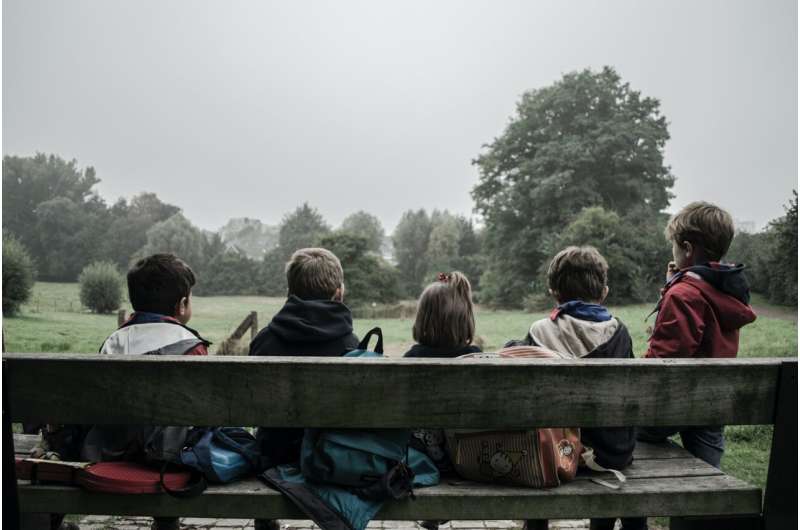

White children who are exposed to larger racial inequalities in their daily lives and who see those inequalities as due to intrinsic differences between people are more likely to hold racial biases in their perceptions of Black children. By contrast, White children with the same levels of inequality exposure and who see external factors as forces driving inequality are less likely to show these same biases.
These findings are reported in the journal Proceedings of the National Academy of Sciences (PNAS).
“What’s crucial in the formation of anti-Black biases are the beliefs that children develop to explain why racial inequalities exist,” says Michael Rizzo, a postdoctoral researcher in New York University’s Department of Psychology and the lead author of the study. “Our findings show that as children observe inequalities in the world around them, those who endorse myths about intrinsic differences between racial groups in turn develop beliefs that reinforce racial biases, whereas those who recognize the extrinsic factors underlying racial inequalities develop more egalitarian attitudes.”
“These results indicate that helping children understand the societal factors that cause racial inequalities could help prevent the development of racial bias in childhood,” notes Marjorie Rhodes, a professor in NYU’s Department of Psychology and the paper’s senior author, adding that additional research would help solidify the value of this approach.
It’s been long established that children develop racial attitudes at a young age—as early as ages four and five. However, less understood are the factors that influence these beliefs. To explore this dynamic, the paper’s authors, who also included Tobias Britton, an NYU researcher, studied racial attitudes of nearly 650 White children, aged 4 to 8, living in more than 450 different zip codes across 47 states and their beliefs about the racial inequalities they see in their neighborhoods. At the time of the study, in 2020, the median family income was 63% higher for White than Black families ($74,912 and $45,870, respectively) and White adults were 46% more likely to have a bachelor’s degree than Black adults (41% and 28%, respectively), according to Census data. Similar disparities were found in the neighborhoods the study participants lived in.
These children were shown photographs of children from different racial backgrounds (Asian, Black, Latinx, and White) and were asked which of those pictured they would want to play with the most. Overall, and consistent with past research, White children of all ages expressed a greater preference to play with other White children than would be expected if they had chosen randomly. By contrast, the White children were significantly less likely to choose to play with the Black and Latinx children than would be expected if they had chosen randomly and expressed a preference to play with Asian children that would be expected if they had chosen randomly.
To understand why many of the children might be developing these biases, the researchers focused on how children think about the racial inequalities they are exposed to in their neighborhoods. They did so by showing them pictures of Black and White children and the houses they lived in; in some trials, a Black family lived in a nicer house than a White family, and in other trials, a White family lived in a nicer house than a Black family.
The authors then asked the children why they thought those families lived in those houses: Was it because of “who they are on the inside” or because of “things that happen in the world”? Children were generally evenly split across the two explanations, with 34% saying it was more because of things that happen in the world, 26% saying it was more because of who they are on the inside, and 40% saying both contributed the same amount. In addition, to assess children’s exposure to racial inequalities in their daily lives, the researchers used the participating children’s zipcode to calculate the racial disparities between Black and White residents’ median family income and college graduation rates in the communities where the children were growing up.
They found notable distinctions among older White children—aged five-and-half and above—living in zip codes with greater racial inequalities. In communities with more racial inequality, older children who believed that racial inequalities were caused by internal factors (“who people are on the inside”) showed more racial bias. That is, they were less likely to choose to play with the Black than White child in the photographs they viewed. By contrast, those who believed that racial inequalities were caused by external factors (“things that happen in the world”) were equally likely to want to play with Black and White children.
“Beliefs about race emerge early in life and vary among children, so identifying how they form is an important first step in understanding how to prevent racial biases from developing,” observes Rizzo. “Our study shows that as White children are exposed to greater levels of inequality in their daily lives, the beliefs they form to explain what causes those inequalities will shape how they treat people from different racial groups.”
More information:
Michael T. Rizzo et al, Developmental origins of anti-Black bias in White children in the United States: Exposure to and beliefs about racial inequality, Proceedings of the National Academy of Sciences (2022). DOI: 10.1073/pnas.2209129119
Provided by
New York University
Citation:
Racial bias in white children linked to beliefs about the causes of inequality, new study finds (2022, November 16)
retrieved 16 November 2022
from https://phys.org/news/2022-11-racial-bias-white-children-linked.html
This document is subject to copyright. Apart from any fair dealing for the purpose of private study or research, no
part may be reproduced without the written permission. The content is provided for information purposes only.